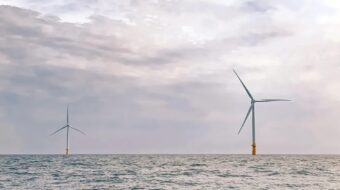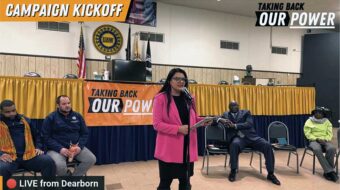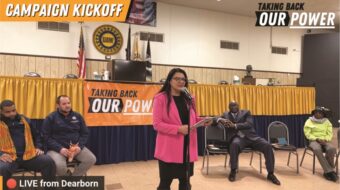Longtime antinuclear and electoral activist/author Harvey Wasserman recently spoke about the fallout from the Fukushima catastrophe and other atomic era calamities-as well as on the worst six days of his life, the private lives of America’s founding fathers and mothers, plus more. Wasserman addressed a packed audience at the posh Westside L.A. apartment of KPFK radio host Lila Garrett. The talk was the 70th installment of “The Great Minds Series” presented by publicist Ilene Proctor. Political science Prof. Peter Mathews, author of “Dollar Democracy,” introduced Wasserman as the implacable foe of what he called “King CONG”-an acronym for coal, oil, nukes and gas.
The veteran alternative energy campaigner, who is credited with coining the catchy, to the point “No Nukes” slogan in 1973, looked like a latter day version of Woodstock musician John Sebastian. The good-natured Wasserman leavened his 90-minute presentation and Q&A with lots of levity-which served to soften the blows of the hard hitting, sometimes frightening allegations he reported.
According to Wasserman, the disastrous March 11, 2011, earthquake and tsunami that struck Japan’s Fukushima Nuclear Power Plant has caused radioactive “stuff from [Japan] to come to California by water by now…. Ten days after Chernobyl a radioactive cloud came down on the Point Reyes bird sanctuary [in California]. A researcher, Dr. David DeSante, discovered that 60% of the baby birds there were killed by the [irradiated] clouds of fallout. At Fukushima 300 tons of radiation per day pour into the Pacific Ocean.”
The “Solartopia” author took issue with the nuclear industry’s oft-cited mantra that “no commercial reactor can explode,” contending that four General Electric reactors have blown up. “The Unit 3 explosion” at the TEPCO (Tokyo Electric Power Company) Fukushima plant “looks like nuclear fission, a mushroom cloud…. They never thought there could be a multiple meltdown.” But, Wasserman noted, “a 9.0 earthquake took place 120 kilometers” from Fukushima, which TEPCO dubiously built right beside the ocean in a country known to experience tidal waves. (As Wasserman acidly observed, “Tsunami is a Japanese word.”) Pulling no punches, Wasserman claimed the extensive “Fukushima cleanup has become a profit center for TEPCO. The Japanese mafia is deeply involved in doing the cleanup…. Get Fukushima away from TEPCO! That site must be taken over by a global body with all the scientific, engineering and financial resources our species can muster.”
The Ohio-based Wasserman went on to say, “Not much official effort has been made to measure what got into the air in California,” although at Fukushima, we know that levels of the radioactive isotope “cesium were 30 times greater than at Hiroshima,” which was, of course, A-bombed by the U.S. during WWII. “The thyroid cancer death rate for children in the Fukushima area is 40 times higher than normal…. Radiation in the Pacific affects sea life…. Tuna caught near California have signs of cesium traceable to Fukushima.” Wasserman, a senior editor of the online and print publication Columbus Free Press (www.freepress.org), groused, “The Japanese government has used the Official State Secrets Act regarding Fukushima” to control the flow of information regarding the near apocalyptic events there.
The renewable energy advocate is no stranger to nuclear power tragedies. “A year after Three Mile Island I spent the worst six days of my life” investigating the March 28, 1979, accident at the N-power plant and partial meltdown in one of its reactors, and how this affected Pennsylvanians. Wasserman alleged that after the TMI cataclysm there was a spike in cancer and leukemia among those located downwind of the plant. In stark contrast to official and mainstream media reports, Wasserman insisted, “many, many were killed at TMI.”
Wasserman also expressed concern over the 1986 Chernobyl N-plant explosion and fire that released massive amounts of radioactive particles in Ukraine, saying only “20 percent of the children in many areas downwind of Chernobyl in Ukraine and Belarus were healthy. Meaning 80 percent are ill. More than 1 million people were killed by radiation.”
Although he painted a grim picture, the experienced organizer also pointed out that the cause has not been without significant victories. In a reference to the 40th anniversary of Tricky Dick’s resignation as president, Wasserman remembered that “Nixon said there would be 1,000 nuclear power plants by the year 2000.” Like so many other things Nixon stated, this has not been borne out: The actual number of plants is far below this glowing prediction, due to widespread concerns surrounding nuclearism, which makes it hard for energy firms to find capitalization for building these safety hazards. Taxpayer money has to be used to back them, but it’s a very expensive-and possibly dangerous-undertaking. Wasserman also scoffed at the notion that “nuclear power fights global warming.”
“We’re at a tipping point,” said Wasserman, noting that renewable energy is becoming more and more cost effective and accessible. “The Koch brothers are terrified of the decentralized power than can come with renewable energy. The Kewaunee, Wisconsin, nuclear power plant shut down [in 2013] because it couldn’t compete with renewable…. A fight for renewable energy is a fight for democracy. A popular referendum shut down a nuclear plant in Sacramento in 1989…. I urge people to find a local reactor and shut it down. It feels better than sex,” laughed Wasserman, who was arrested in 1984 while protesting against the Diablo Canyon facility, and participated in the successful movement to close the San Onofre N-plant. (Both installations are located in the Golden State. Citing earthquake concerns, on Aug. 26 Friends of the Earth filed a petition with the Nuclear Regulatory Commission seeking closure of the appropriately named Diablo Canyon plant.)
Some may find Wasserman to be an alarmist, while others regard him as a prophet. In any case, he is also a jokester and on the, uh, lighter side this ’60s “leftover” advocated “legalization of hemp and marijuana.” However, the kibitzer asserted, “I don’t smoke marijuana-it gives me headaches, makes me paranoid, and reminds me of George W. Bush.” Wasserman (who is also a historian: His lefty “History of the U.S.” is introduced by the people’s historian, Howard Zinn) has taken a stab at fiction as well, writing the historical novel “Passions of the Pot Smoking Patriots,” which purports to be a “lost manuscript” by the revolutionary Thomas Paine. At the close of his illuminating, sometimes scary and humorous “Great Mind” talk, the anti-nuclear merry prankster left his listeners with this fun fact: “Hemp was the number two cash crop behind tobacco in the 13 colonies.” (See: http://solartopia.org/store/).
L.A.-based journalist and reviewer Ed Rampell co-authored “The Hawaii Movie and Television Book” (see: http://hawaiimtvbook.weebly.com/).
Photo: Harvey Wasserman stands with the late Pete Seeger and children’s nature book author Lynne Cherry, Dec. 3, 2012. (Solartopia.org/Connie Hogarth).

MOST POPULAR TODAY


Zionist organizations leading campaign to stop ceasefire resolutions in D.C. area

Afghanistan’s socialist years: The promising future killed off by U.S. imperialism

High Court essentially bans demonstrations, freedom of assembly in Deep South

Communist Karol Cariola elected president of Chile’s legislature






Comments